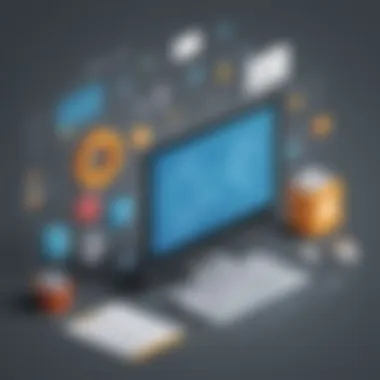Crafting a Stellar Post-Interview Follow-Up Email: Expert Guide


Tech Insights
Crafting an impressive follow-up email after an interview requires finesse and strategic thinking. It's not just about sending a generic message; it's about showcasing your professionalism and interest in the position. To stand out among other candidates, your follow-up email needs to be thoughtful, concise, and tailored to the conversation you had during the interview. This section will delve into the critical aspects of composing a follow-up email that leaves a lasting impression on potential employers.
Overview of Crafting an Impressive Follow-up Email Understanding the significance of a follow-up email Setting the right tone and format Emphasizing key details discussed during the interview Tailoring the content to reflect your interest and suitability for the role Highlighting professionalism and attention to detail
Crafting the Perfect Subject Line The subject line is the first thing a recipient sees in an email, making it crucial to craft it carefully. A compelling subject line should be concise, relevant, and enticing. It should grab the reader's attention without being generic or overly promotional. The right subject line can increase the chances of your email being opened and read by the recipient. In this segment, we will explore effective strategies for creating captivating subject lines that pique interest and encourage engagement.
Personalizing Your Content Personalization is key to making your follow-up email memorable. By referencing specific points discussed in the interview or highlighting how your skills align with the company's needs, you show that you are attentive and genuinely interested in the opportunity. This section will provide insights on personalizing your follow-up email to make a meaningful impact and increase your chances of being noticed by recruiters and hiring managers.
Introduction
Understanding the Importance of a Follow-up Email
Expressing Gratitude
In the realm of post-interview communication, expressing gratitude plays a crucial role. It signifies appreciation for the opportunity while demonstrating courtesy and respect. By showcasing gratitude in a follow-up email, candidates can establish a positive rapport with the interviewer, reflecting a polite and thankful demeanor. This choice is popular as it sets a gracious tone and fosters goodwill in the professional relationship.
Reiterating Interest
Reiterating interest reinforces the candidate's enthusiasm for the position. It acts as a subtle reminder of their keenness to be part of the organization, reaffirming their passion and commitment. This aspect showcases proactiveness and engagement, positioning the candidate favorably in the recruiter's view. Despite potential risks of sounding repetitive, the advantage lies in reaffirming commitment and suitability for the role.
Showcasing Professionalism
Showcasing professionalism underscores the candidate's competency and reliability. It involves communication that is polished, courteous, and aligned with professional standards. This aspect exudes confidence and capability, indicating to the employer that the candidate is serious about the position. The advantage of professionalism is the impression of a capable and composed individual, critical in competitive job markets.
Setting the Right Tone
Formal vs. Informal Language
Choosing between formal and informal language impacts the tone of the email significantly. Formal language exudes professionalism and respect, ideal for initial and formal communication. In contrast, informal language may seem overly casual or disrespectful in professional settings. The unique feature of this choice lies in the ability to convey the desired level of formality and respect, crucial in professional correspondence.


Avoiding Overly Familiar Phrases
Avoiding overly familiar phrases helps maintain a professional and respectful tone. It prevents the email from becoming too casual or presumptuous, ensuring that the candidate's communication remains appropriate and business-like. By steering clear of colloquial language or slang, the candidate upholds a sense of decorum and professionalism. The advantage here is the preservation of a respectful and dignified demeanor in correspondence.
Emphasizing Professionalism
Emphasizing professionalism establishes the candidate as a serious and capable individual. It involves adhering to formal language, structure, and etiquette, showcasing respect for professional boundaries. By emphasizing professionalism, the candidate can create a positive impression of competence and reliability. The strength of this approach lies in projecting a polished and competent image to the employer, crucial in a competitive job market.
Structuring Your Email Effectively
Subject Line Strategies
Crafting an effective subject line is vital to capture the recipient's attention. It should be concise, relevant, and engaging, offering a glimpse of the email's content. A strong subject line increases the likelihood of the email being opened and read promptly. The unique feature of this strategy is its ability to initiate interest and set the tone for the email's content, enhancing its impact.
Opening Greetings
The opening greeting sets the tone for the entire email and establishes a courteous and respectful beginning. It should address the recipient appropriately, striking a balance between professionalism and warmth. A well-crafted opening greeting creates a positive first impression and sets the stage for the following discussion. The advantage of this practice is the initiation of the email on a polite and welcoming note, laying the foundation for effective communication.
Body Content Guidelines
Ensuring the body content is structured and coherent is essential for conveying the intended message clearly. It should be organized logically, with each paragraph addressing a specific point or topic. Clarity and conciseness are key in maintaining the reader's interest and enhancing comprehension. The unique feature of this guideline is its ability to present information in a clear and digestible manner, facilitating effective communication.
Closing Remarks
Closing remarks serve as a conclusion to the email, summarizing key points and expressing gratitude once again. They should be concise, impactful, and leave a positive impression on the recipient. A well-crafted closing reinforces the candidate's interest in the position and leaves the door open for further communication. The advantage of thoughtful closing remarks is the reinforcement of professionalism and engagement, crucial in post-interview correspondence.
Key Elements to Include
Crafting an impressive follow-up email after an interview requires careful consideration of various key elements. These elements play a crucial role in leaving a positive impression on potential employers and setting yourself apart from other candidates. Personalized touches are essential to make your email stand out, such as referencing specific details from the interview, mentioning shared interests or connections, and highlighting relevant skills or experiences. By incorporating these personalized aspects, you demonstrate genuine interest in the position and showcase why you are the ideal candidate.
Personalized Touches
Referencing Specific Details from the Interview


Referencing specific details from the interview adds a personal touch to your follow-up email. It shows that you were attentive during the interview and highlights your ability to recall important discussions. This personalized approach helps you establish a deeper connection with the interviewer, reinforcing your interest in the role. By incorporating specific interview details, you demonstrate thorough preparation and genuine enthusiasm for the opportunity.
Mentioning Shared Interests or Connections
Mentioning shared interests or connections in your follow-up email can help foster a sense of camaraderie with the interviewer. Finding common ground outside of the professional realm demonstrates your ability to build rapport and connect on a more personal level. This can leave a lasting impression and differentiate you from other candidates. By highlighting shared interests, you show that you are not only qualified for the position but also culturally aligned with the company.
Highlighting Relevant Skills or Experiences
Highlighting relevant skills or experiences in your follow-up email reinforces your suitability for the role. By emphasizing key qualifications that align with the job requirements, you reaffirm your value as a prospective employee. This personalized approach allows you to tailor your communication to the specific needs of the employer, showcasing how your skills can contribute to the organization's success. By focusing on relevant skills and experiences, you demonstrate your potential to excel in the position.
Reiterating Your Qualifications
Summarizing Key Points Discussed in the Interview
Summarizing key points discussed in the interview helps reinforce your qualifications and alignment with the role. By providing a brief recap of important discussions, you ensure that your key selling points are fresh in the interviewer's mind. This summary serves as a reminder of why you are a strong fit for the position, showcasing your abilities and competencies. By reiterating key points, you reaffirm your candidacy and highlight your suitability for the role.
Showcasing Why You're the Ideal Candidate
Showcasing why you're the ideal candidate allows you to reinforce your unique value proposition. By articulating what sets you apart from other applicants, you differentiate yourself as the top choice for the role. This section of your follow-up email is an opportunity to highlight specific traits, experiences, or accomplishments that position you as the perfect fit. By showcasing why you're the ideal candidate, you make a compelling case for why the employer should choose you.
Addressing Any Additional Information
Addressing any additional information in your follow-up email demonstrates thoroughness and proactive communication. If there are relevant details or updates that were not covered in the interview, this is the time to address them. Providing supplementary information shows your attention to detail and commitment to transparency. By addressing any additional information, you ensure that the employer has a comprehensive view of your candidacy and qualifications.
Call-to-Action
Expressing Eagerness for Next Steps
Expressing eagerness for next steps in your follow-up email conveys your proactive approach and enthusiasm for the opportunity. By indicating your interest in advancing to the next stage of the hiring process, you demonstrate your commitment to the role. This call-to-action encourages the employer to move forward with your application and sets a positive tone for future interactions. By expressing eagerness for next steps, you pave the way for continued engagement with the employer.
Seeking Clarifications or Additional Information
Seeking clarifications or additional information in your follow-up email shows that you are detail-oriented and value clear communication. If there are any unresolved queries or areas that require further elaboration, this is an opportunity to seek clarification. By asking thoughtful questions and demonstrating your quest for information, you exhibit your thorough approach to the application process. Seeking clarifications or additional information helps ensure that both parties are on the same page and moving forward effectively.


Requesting a Follow-up Meeting
Requesting a follow-up meeting in your email indicates your interest in further discussing your candidacy in person. If there are aspects of your application that you believe would be better addressed in a face-to-face conversation, this is a chance to request a meeting. A follow-up meeting can provide an opportunity to delve deeper into your qualifications, clarify any points of confusion, and reinforce your enthusiasm for the role. By requesting a follow-up meeting, you express your willingness to engage further and explore how you can contribute to the organization's success.
Additional Tips and Best Practices
When it comes to crafting post-interview follow-up emails, paying attention to additional tips and best practices can make a significant difference in setting yourself apart as a candidate. These guidelines go beyond the basic structure of the email and focus on elements like proofreading, timeliness, and etiquette. By incorporating these practices, you can demonstrate not only your attention to detail but also your professionalism and keen interest in the position. With competition being fierce in the job market, ensuring that your follow-up email adheres to best practices can be the key to leaving a lasting impression.
Proofreading and Editing
Checking for Grammatical Errors
Checking for grammatical errors is an essential aspect of crafting an effective follow-up email. It contributes to the overall professionalism of the message and reflects your communication skills. By paying close attention to grammatical accuracy, you can convey your thoughts clearly and precisely, showcasing your competence to potential employers. Additionally, error-free content can elevate the readability of your email, ensuring that your message is well-received and leaves a positive impact.
Ensuring Clarity and Coherence
Ensuring clarity and coherence in your follow-up email is crucial for making your points effectively. Clear and coherent communication enhances the understanding of your message, making it easier for the recipient to grasp your intentions. Maintaining a logical flow of ideas can help you present your qualifications and enthusiasm in a structured manner, reinforcing your suitability for the role.
Seeking Feedback from a Trusted Source
Seeking feedback from a trusted source can provide valuable insights into how your follow-up email is perceived. External perspectives can offer constructive criticism and suggestions for improvement, guiding you in refining your content. By incorporating feedback, you can address any potential shortcomings in your email and enhance its impact, ensuring that your message resonates with the recipient.
Timeliness and Follow-up Etiquette
Sending the Email Promptly
Sending the follow-up email promptly demonstrates your eagerness and proactive approach towards the opportunity. Timeliness reflects your professionalism and respect for the recipient's time, indicating that you value the communication exchange. Moreover, a timely response keeps you top-of-mind for the employer, signaling your interest and engagement in the selection process.
Respecting the Hiring Timeline
Respecting the hiring timeline established by the employer is essential for maintaining a positive relationship. Adhering to the specified deadlines showcases your commitment and reliability, contributing to a favorable impression. By acknowledging and respecting the stipulated timeframe, you exhibit your ability to follow instructions and collaborate effectively, essential qualities in any professional setting.
Following Up Appropriately
Following up appropriately after sending the initial email involves striking a balance between persistence and discretion. A well-timed and polite follow-up demonstrates your enthusiasm without appearing overly aggressive. By approaching the follow-up tactfully, you reinforce your interest in the role while respecting the recipient's decision-making process. This considerate approach can leave a favorable impression and distinguish you as a courteous and attentive candidate.
Final Thoughts
In concluding your follow-up email, several key aspects deserve special attention to solidify your stand as a strong candidate. Embracing confidence and professionalism in your communication reflects your self-assurance and competence, underlining your suitability for the role. Maintaining a positive attitude throughout the interaction conveys your optimism and enthusiasm, traits that are valued in a potential team member. Additionally, continuing the dialogue with employers beyond the initial email demonstrates your proactive stance and commitment to building a meaningful relationship. By incorporating these aspects in your final thoughts, you can leave a lasting impression that resonates with the hiring team.



